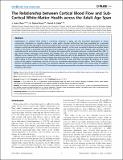| dc.contributor.author | Chen, J. Jean | |
| dc.contributor.author | Rosas, H. Diana | |
| dc.contributor.author | Salat, David H. | |
| dc.date.accessioned | 2013-04-26T18:09:52Z | |
| dc.date.issued | 2013 | |
| dc.identifier.citation | Chen, J. Jean, H. Diana Rosas, and David H. Salat. 2013. The relationship between cortical blood flow and sub-cortical white-matter health across the adult age span. PLoS ONE 8(2): e56733. | en_US |
| dc.identifier.issn | 1932-6203 | en_US |
| dc.identifier.uri | http://nrs.harvard.edu/urn-3:HUL.InstRepos:10589799 | |
| dc.description.abstract | Degeneration of cerebral white matter is commonly observed in aging, and the associated degradation in neural connectivity contributes to cognitive decline in older adults. Vascular dysfunction has been implicated as a potential mechanism for general age-related neural tissue deterioration; however, no prior study has examined the direct relationship between cortical vascular health and subcortical white-matter integrity. In this work, we aimed to determine whether blood supply to the brain is associated with microstructural integrity of connective tissue, and whether such associations are regionally specific and mainly accounted for by aging. We examined the association between cerebral blood flow (CBF) in the cortical mantle, measured using arterial spin labeling (ASL), and subcortical white-matter integrity, measured using diffusion tensor imaging (DTI), in a group of healthy adults spanning early to late adulthood. We found cortical CBF to be significantly associated with white-matter integrity throughout the brain. In addition, these associations were only partially tied to aging, as they remained even when statistically controlling for age, and when restricting the analyses to a young subset of the sample. Furthermore, vascular risk was not a prominent determinant of these effects. These findings suggest that the overall blood supply to the brain is an important indicator of white-matter health in the normal range of variations amongst adults, and that the decline in CBF with advancing age may potentially exacerbate deterioration of the connective anatomy of the brain. | en_US |
| dc.language.iso | en_US | en_US |
| dc.publisher | Public Library of Science | en_US |
| dc.relation.isversionof | doi:10.1371/journal.pone.0056733 | en_US |
| dc.relation.hasversion | http://www.ncbi.nlm.nih.gov/pmc/articles/PMC3578934/pdf/ | en_US |
| dash.license | LAA | |
| dc.subject | Biology | en_US |
| dc.subject | Anatomy and Physiology | en_US |
| dc.subject | Neurological System | en_US |
| dc.subject | Neuroanatomy | en_US |
| dc.subject | Physiological Processes | en_US |
| dc.subject | Aging | en_US |
| dc.subject | Biophysics | en_US |
| dc.subject | Developmental Biology | en_US |
| dc.subject | Organism Development | en_US |
| dc.subject | Neuroscience | en_US |
| dc.subject | Systems Biology | en_US |
| dc.subject | Medicine | en_US |
| dc.subject | Geriatrics | en_US |
| dc.subject | Neurology | en_US |
| dc.subject | Neuroimaging | en_US |
| dc.title | The Relationship between Cortical Blood Flow and Sub-Cortical White-Matter Health across the Adult Age Span | en_US |
| dc.type | Journal Article | en_US |
| dc.description.version | Version of Record | en_US |
| dc.relation.journal | PLoS ONE | en_US |
| dash.depositing.author | Rosas, H. Diana | |
| dc.date.available | 2013-04-26T18:09:52Z | |
| dc.identifier.doi | 10.1371/journal.pone.0056733 | * |
| dash.contributor.affiliated | Rosas, Herminia | |
| dash.contributor.affiliated | Salat, David | |


